Equity and Liability Analysis: Woolsworth and Wesfarmers Comparison
VerifiedAdded on 2022/10/18
|17
|3088
|15
Report
AI Summary
This report undertakes a comprehensive financial statement analysis, focusing on the equity and liability sections of Woolworths Group and Wesfarmers Group. It begins with an introduction to both companies, outlining their core businesses and market positions. The report then delves into the analysis of the owners' equity sections, detailing components such as contributed equity, reserves, and retained earnings for both companies. It examines the movements in each equity item over a three-year period, highlighting factors contributing to changes in share capital, reserves, and retained earnings. The liability section is then analyzed, covering items such as trade payables, borrowings, and provisions. The report discusses the movement in each liability item and concludes with a comparison of the advantages and disadvantages of different funding sources for each company. The report also includes an analysis of the three types of entities and concludes with the references used.
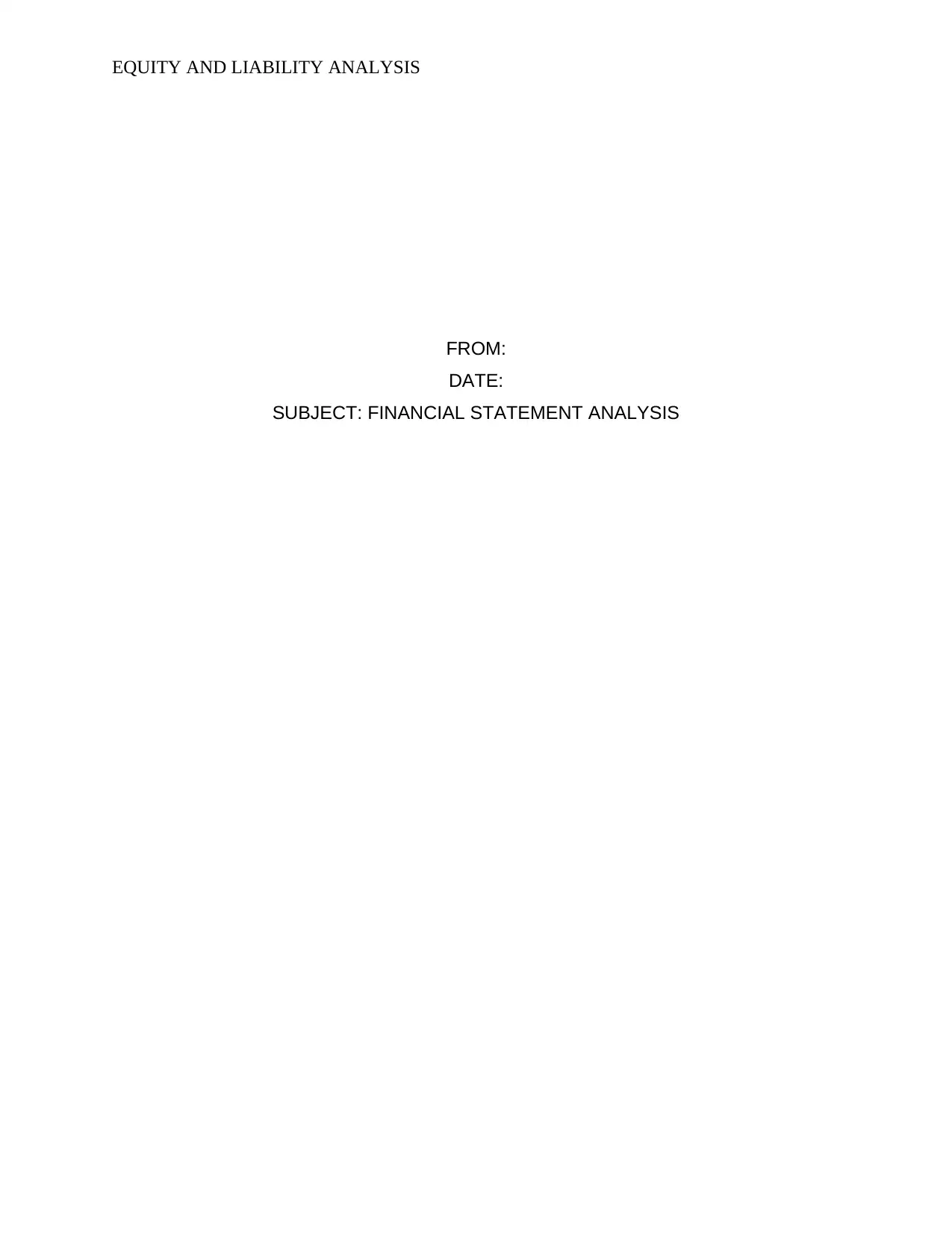
EQUITY AND LIABILITY ANALYSIS
FROM:
DATE:
SUBJECT: FINANCIAL STATEMENT ANALYSIS
FROM:
DATE:
SUBJECT: FINANCIAL STATEMENT ANALYSIS
Paraphrase This Document
Need a fresh take? Get an instant paraphrase of this document with our AI Paraphraser
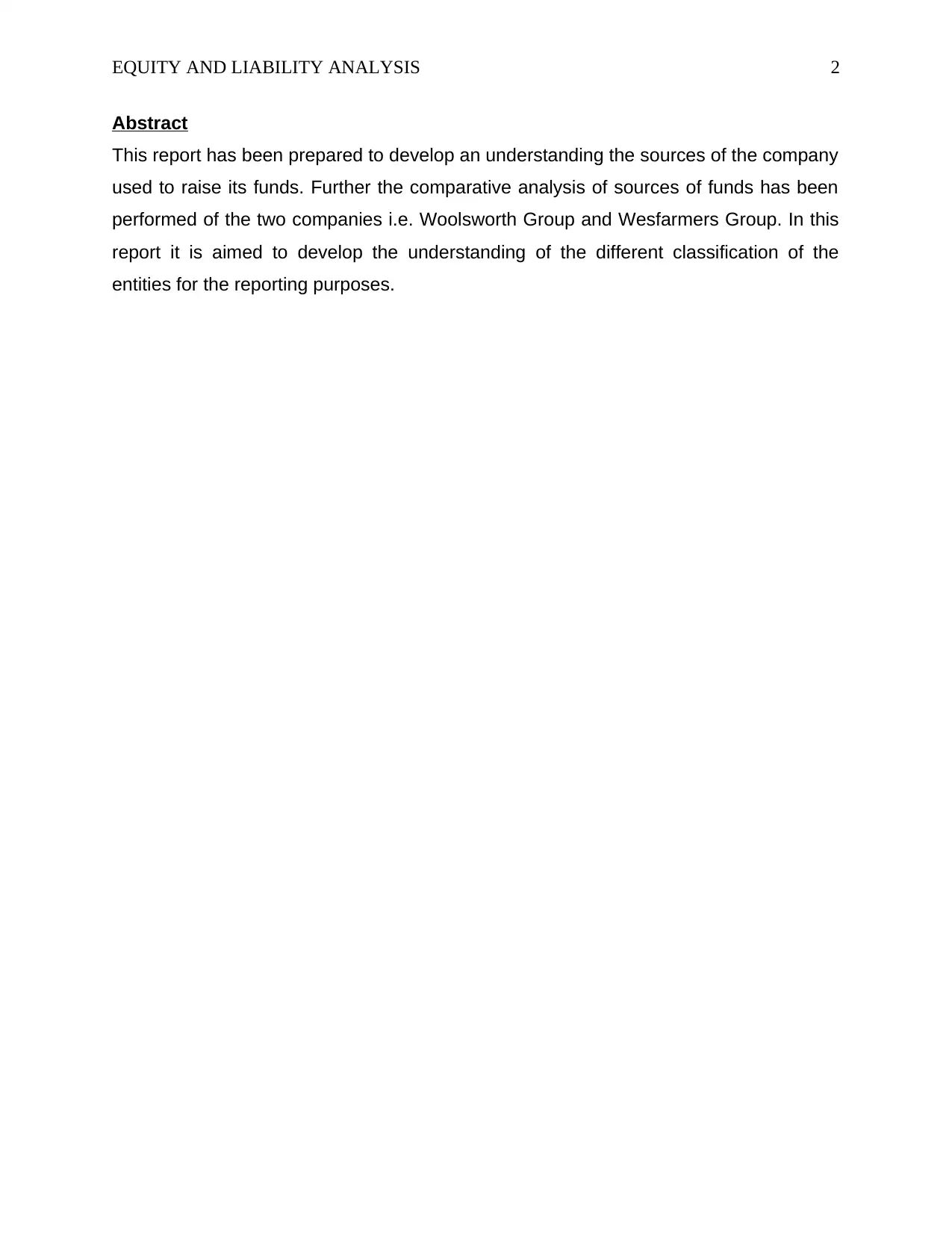
EQUITY AND LIABILITY ANALYSIS 2
Abstract
This report has been prepared to develop an understanding the sources of the company
used to raise its funds. Further the comparative analysis of sources of funds has been
performed of the two companies i.e. Woolsworth Group and Wesfarmers Group. In this
report it is aimed to develop the understanding of the different classification of the
entities for the reporting purposes.
Abstract
This report has been prepared to develop an understanding the sources of the company
used to raise its funds. Further the comparative analysis of sources of funds has been
performed of the two companies i.e. Woolsworth Group and Wesfarmers Group. In this
report it is aimed to develop the understanding of the different classification of the
entities for the reporting purposes.

EQUITY AND LIABILITY ANALYSIS 3
Table of Contents
Introduction................................................................................................................................4
Analysis of the financial statement of the companies ...............................................................4
Analysis of the owners’ equity section...................................................................................4-6
Movement in each item of the equity section.........................................................................6-8
Items recorded under liability section...................................................................................9-10
Movement in each item of the liability section ...................................................................10-12
Advantages and disadvantages of the source of fund for each company.……………………13
Analysis of three types of the entity...................................................................................13-14
Conclusion................................................................................................................................15
References................................................................................................................................16
Table of Contents
Introduction................................................................................................................................4
Analysis of the financial statement of the companies ...............................................................4
Analysis of the owners’ equity section...................................................................................4-6
Movement in each item of the equity section.........................................................................6-8
Items recorded under liability section...................................................................................9-10
Movement in each item of the liability section ...................................................................10-12
Advantages and disadvantages of the source of fund for each company.……………………13
Analysis of three types of the entity...................................................................................13-14
Conclusion................................................................................................................................15
References................................................................................................................................16
⊘ This is a preview!⊘
Do you want full access?
Subscribe today to unlock all pages.

Trusted by 1+ million students worldwide
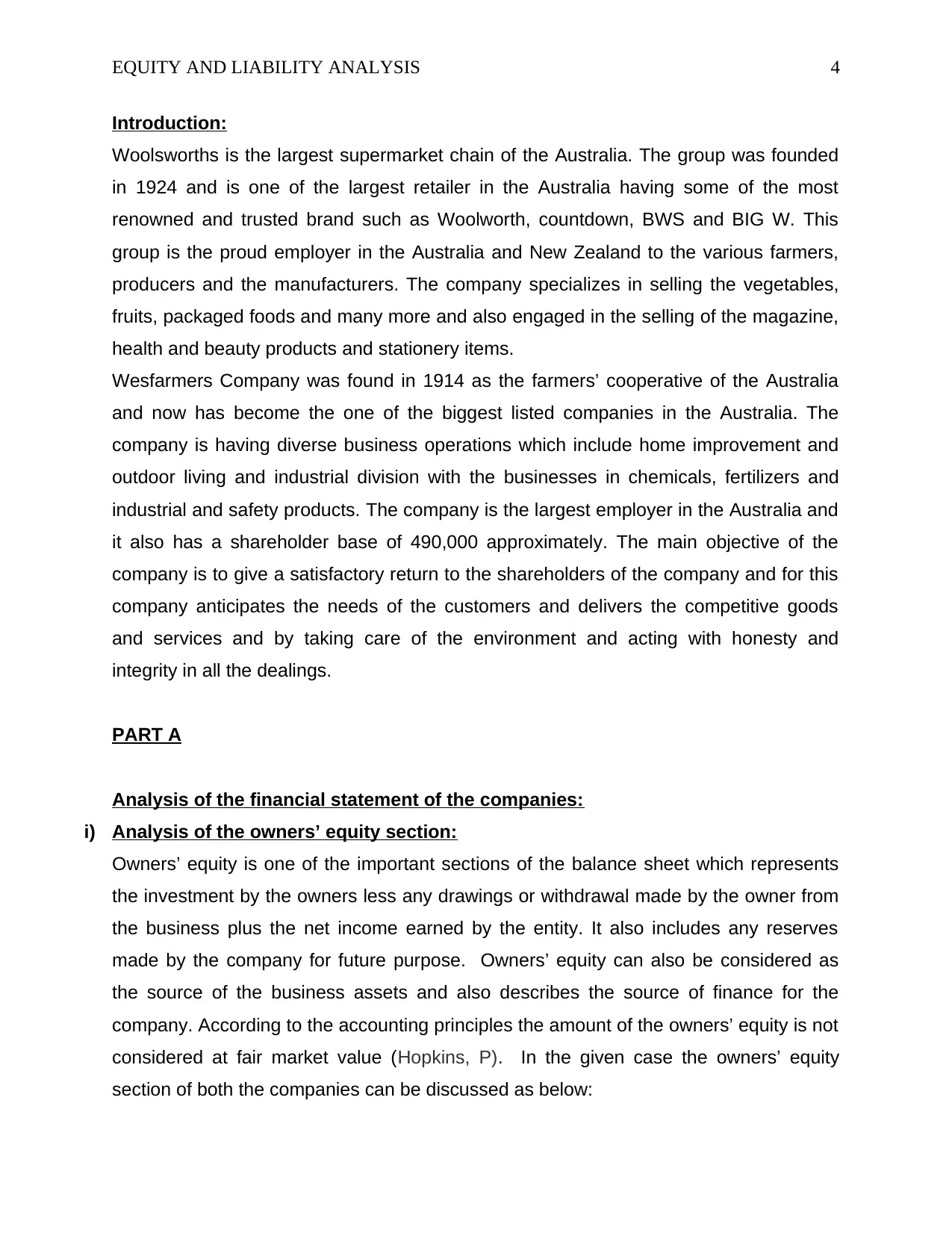
EQUITY AND LIABILITY ANALYSIS 4
Introduction:
Woolsworths is the largest supermarket chain of the Australia. The group was founded
in 1924 and is one of the largest retailer in the Australia having some of the most
renowned and trusted brand such as Woolworth, countdown, BWS and BIG W. This
group is the proud employer in the Australia and New Zealand to the various farmers,
producers and the manufacturers. The company specializes in selling the vegetables,
fruits, packaged foods and many more and also engaged in the selling of the magazine,
health and beauty products and stationery items.
Wesfarmers Company was found in 1914 as the farmers’ cooperative of the Australia
and now has become the one of the biggest listed companies in the Australia. The
company is having diverse business operations which include home improvement and
outdoor living and industrial division with the businesses in chemicals, fertilizers and
industrial and safety products. The company is the largest employer in the Australia and
it also has a shareholder base of 490,000 approximately. The main objective of the
company is to give a satisfactory return to the shareholders of the company and for this
company anticipates the needs of the customers and delivers the competitive goods
and services and by taking care of the environment and acting with honesty and
integrity in all the dealings.
PART A
Analysis of the financial statement of the companies:
i) Analysis of the owners’ equity section:
Owners’ equity is one of the important sections of the balance sheet which represents
the investment by the owners less any drawings or withdrawal made by the owner from
the business plus the net income earned by the entity. It also includes any reserves
made by the company for future purpose. Owners’ equity can also be considered as
the source of the business assets and also describes the source of finance for the
company. According to the accounting principles the amount of the owners’ equity is not
considered at fair market value (Hopkins, P). In the given case the owners’ equity
section of both the companies can be discussed as below:
Introduction:
Woolsworths is the largest supermarket chain of the Australia. The group was founded
in 1924 and is one of the largest retailer in the Australia having some of the most
renowned and trusted brand such as Woolworth, countdown, BWS and BIG W. This
group is the proud employer in the Australia and New Zealand to the various farmers,
producers and the manufacturers. The company specializes in selling the vegetables,
fruits, packaged foods and many more and also engaged in the selling of the magazine,
health and beauty products and stationery items.
Wesfarmers Company was found in 1914 as the farmers’ cooperative of the Australia
and now has become the one of the biggest listed companies in the Australia. The
company is having diverse business operations which include home improvement and
outdoor living and industrial division with the businesses in chemicals, fertilizers and
industrial and safety products. The company is the largest employer in the Australia and
it also has a shareholder base of 490,000 approximately. The main objective of the
company is to give a satisfactory return to the shareholders of the company and for this
company anticipates the needs of the customers and delivers the competitive goods
and services and by taking care of the environment and acting with honesty and
integrity in all the dealings.
PART A
Analysis of the financial statement of the companies:
i) Analysis of the owners’ equity section:
Owners’ equity is one of the important sections of the balance sheet which represents
the investment by the owners less any drawings or withdrawal made by the owner from
the business plus the net income earned by the entity. It also includes any reserves
made by the company for future purpose. Owners’ equity can also be considered as
the source of the business assets and also describes the source of finance for the
company. According to the accounting principles the amount of the owners’ equity is not
considered at fair market value (Hopkins, P). In the given case the owners’ equity
section of both the companies can be discussed as below:
Paraphrase This Document
Need a fresh take? Get an instant paraphrase of this document with our AI Paraphraser

EQUITY AND LIABILITY ANALYSIS 5
Owners’ equity section of Woolworths Limited:
The owners’ equity section of the Woolworth Company consists of the following line
item:
a) Contributed Equity
b) Reserves
c) Retained earnings
Owners’ equity section of Wesfarmers Limited
The owners’ equity section of the Wesfarmers Company consists of the following line
item:
a) Issued capital
b) Reserved shares
c) Retained earnings
d) Reserves
Contributed capital is also known as paid in capital and can be defined as the cash
and other assets that the shareholder has given to the entity in exchange for stock. In
other words this can be stated as the price which the shareholder pays for acquiring
their stake in the company. It includes money from the initial public offerings, direct
listing and also includes issue of preferred stock. It also includes the receipt of the fixed
assets in exchange for stock and reducing the liability in exchange for stock.
Issued capital can be defined as the shares which are sold and held by the investors of
the entity and investors include large institutions or retail investors. It can be simply
described as the money value of the shares of the stock which the entity actually offers
for sale to the investors.
Reserved shares can be defined as the shares which are part of the authorized share
which are set aside for the issuance in the future. In addition to this shares are
reserved for the issuance under the stock option plan. These reserved shares are part
of the number of the authorized shares but the company does not issue them except in
Owners’ equity section of Woolworths Limited:
The owners’ equity section of the Woolworth Company consists of the following line
item:
a) Contributed Equity
b) Reserves
c) Retained earnings
Owners’ equity section of Wesfarmers Limited
The owners’ equity section of the Wesfarmers Company consists of the following line
item:
a) Issued capital
b) Reserved shares
c) Retained earnings
d) Reserves
Contributed capital is also known as paid in capital and can be defined as the cash
and other assets that the shareholder has given to the entity in exchange for stock. In
other words this can be stated as the price which the shareholder pays for acquiring
their stake in the company. It includes money from the initial public offerings, direct
listing and also includes issue of preferred stock. It also includes the receipt of the fixed
assets in exchange for stock and reducing the liability in exchange for stock.
Issued capital can be defined as the shares which are sold and held by the investors of
the entity and investors include large institutions or retail investors. It can be simply
described as the money value of the shares of the stock which the entity actually offers
for sale to the investors.
Reserved shares can be defined as the shares which are part of the authorized share
which are set aside for the issuance in the future. In addition to this shares are
reserved for the issuance under the stock option plan. These reserved shares are part
of the number of the authorized shares but the company does not issue them except in
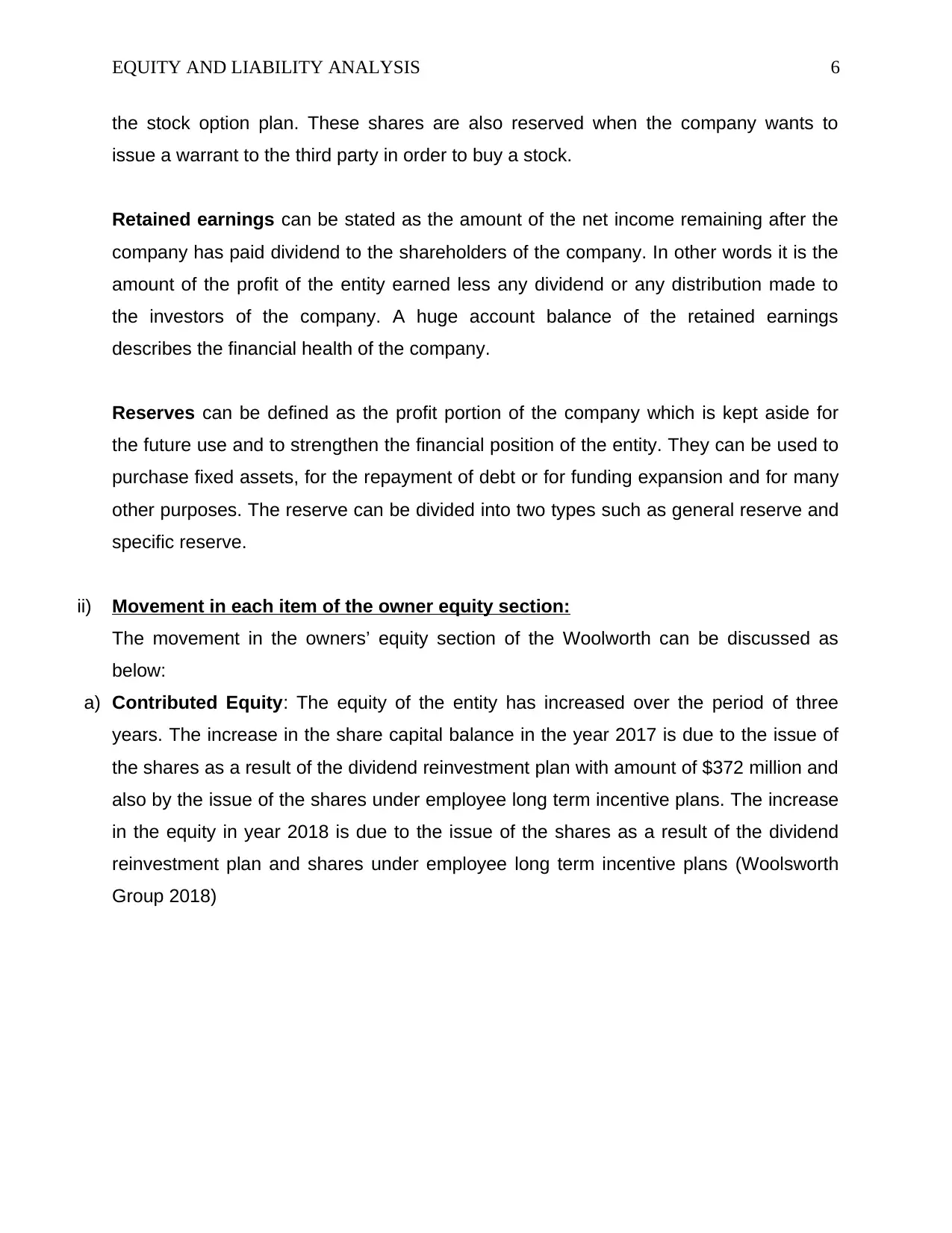
EQUITY AND LIABILITY ANALYSIS 6
the stock option plan. These shares are also reserved when the company wants to
issue a warrant to the third party in order to buy a stock.
Retained earnings can be stated as the amount of the net income remaining after the
company has paid dividend to the shareholders of the company. In other words it is the
amount of the profit of the entity earned less any dividend or any distribution made to
the investors of the company. A huge account balance of the retained earnings
describes the financial health of the company.
Reserves can be defined as the profit portion of the company which is kept aside for
the future use and to strengthen the financial position of the entity. They can be used to
purchase fixed assets, for the repayment of debt or for funding expansion and for many
other purposes. The reserve can be divided into two types such as general reserve and
specific reserve.
ii) Movement in each item of the owner equity section:
The movement in the owners’ equity section of the Woolworth can be discussed as
below:
a) Contributed Equity: The equity of the entity has increased over the period of three
years. The increase in the share capital balance in the year 2017 is due to the issue of
the shares as a result of the dividend reinvestment plan with amount of $372 million and
also by the issue of the shares under employee long term incentive plans. The increase
in the equity in year 2018 is due to the issue of the shares as a result of the dividend
reinvestment plan and shares under employee long term incentive plans (Woolsworth
Group 2018)
the stock option plan. These shares are also reserved when the company wants to
issue a warrant to the third party in order to buy a stock.
Retained earnings can be stated as the amount of the net income remaining after the
company has paid dividend to the shareholders of the company. In other words it is the
amount of the profit of the entity earned less any dividend or any distribution made to
the investors of the company. A huge account balance of the retained earnings
describes the financial health of the company.
Reserves can be defined as the profit portion of the company which is kept aside for
the future use and to strengthen the financial position of the entity. They can be used to
purchase fixed assets, for the repayment of debt or for funding expansion and for many
other purposes. The reserve can be divided into two types such as general reserve and
specific reserve.
ii) Movement in each item of the owner equity section:
The movement in the owners’ equity section of the Woolworth can be discussed as
below:
a) Contributed Equity: The equity of the entity has increased over the period of three
years. The increase in the share capital balance in the year 2017 is due to the issue of
the shares as a result of the dividend reinvestment plan with amount of $372 million and
also by the issue of the shares under employee long term incentive plans. The increase
in the equity in year 2018 is due to the issue of the shares as a result of the dividend
reinvestment plan and shares under employee long term incentive plans (Woolsworth
Group 2018)
⊘ This is a preview!⊘
Do you want full access?
Subscribe today to unlock all pages.

Trusted by 1+ million students worldwide
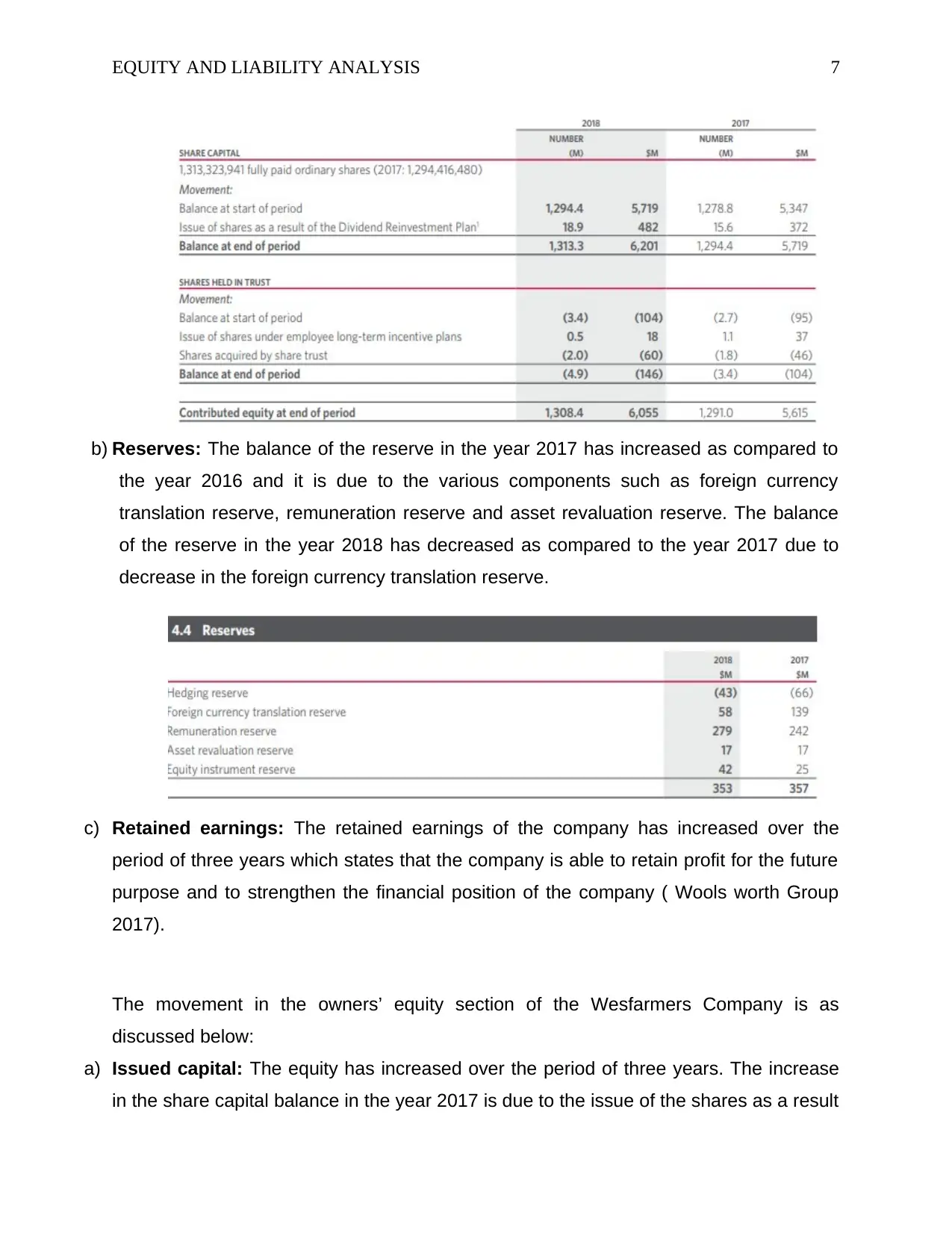
EQUITY AND LIABILITY ANALYSIS 7
b) Reserves: The balance of the reserve in the year 2017 has increased as compared to
the year 2016 and it is due to the various components such as foreign currency
translation reserve, remuneration reserve and asset revaluation reserve. The balance
of the reserve in the year 2018 has decreased as compared to the year 2017 due to
decrease in the foreign currency translation reserve.
c) Retained earnings: The retained earnings of the company has increased over the
period of three years which states that the company is able to retain profit for the future
purpose and to strengthen the financial position of the company ( Wools worth Group
2017).
The movement in the owners’ equity section of the Wesfarmers Company is as
discussed below:
a) Issued capital: The equity has increased over the period of three years. The increase
in the share capital balance in the year 2017 is due to the issue of the shares as a result
b) Reserves: The balance of the reserve in the year 2017 has increased as compared to
the year 2016 and it is due to the various components such as foreign currency
translation reserve, remuneration reserve and asset revaluation reserve. The balance
of the reserve in the year 2018 has decreased as compared to the year 2017 due to
decrease in the foreign currency translation reserve.
c) Retained earnings: The retained earnings of the company has increased over the
period of three years which states that the company is able to retain profit for the future
purpose and to strengthen the financial position of the company ( Wools worth Group
2017).
The movement in the owners’ equity section of the Wesfarmers Company is as
discussed below:
a) Issued capital: The equity has increased over the period of three years. The increase
in the share capital balance in the year 2017 is due to the issue of the shares as a result
Paraphrase This Document
Need a fresh take? Get an instant paraphrase of this document with our AI Paraphraser
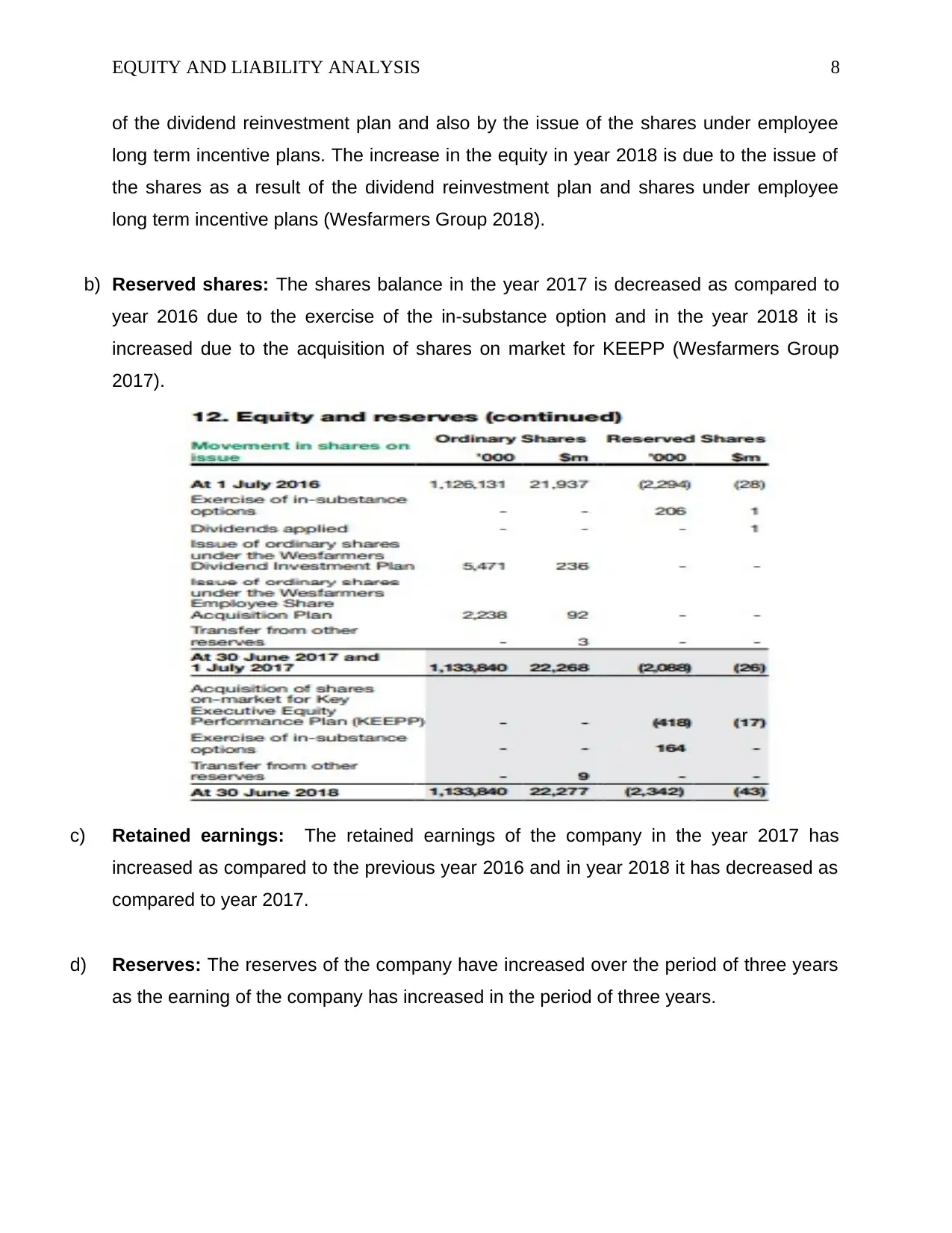
EQUITY AND LIABILITY ANALYSIS 8
of the dividend reinvestment plan and also by the issue of the shares under employee
long term incentive plans. The increase in the equity in year 2018 is due to the issue of
the shares as a result of the dividend reinvestment plan and shares under employee
long term incentive plans (Wesfarmers Group 2018).
b) Reserved shares: The shares balance in the year 2017 is decreased as compared to
year 2016 due to the exercise of the in-substance option and in the year 2018 it is
increased due to the acquisition of shares on market for KEEPP (Wesfarmers Group
2017).
c) Retained earnings: The retained earnings of the company in the year 2017 has
increased as compared to the previous year 2016 and in year 2018 it has decreased as
compared to year 2017.
d) Reserves: The reserves of the company have increased over the period of three years
as the earning of the company has increased in the period of three years.
of the dividend reinvestment plan and also by the issue of the shares under employee
long term incentive plans. The increase in the equity in year 2018 is due to the issue of
the shares as a result of the dividend reinvestment plan and shares under employee
long term incentive plans (Wesfarmers Group 2018).
b) Reserved shares: The shares balance in the year 2017 is decreased as compared to
year 2016 due to the exercise of the in-substance option and in the year 2018 it is
increased due to the acquisition of shares on market for KEEPP (Wesfarmers Group
2017).
c) Retained earnings: The retained earnings of the company in the year 2017 has
increased as compared to the previous year 2016 and in year 2018 it has decreased as
compared to year 2017.
d) Reserves: The reserves of the company have increased over the period of three years
as the earning of the company has increased in the period of three years.
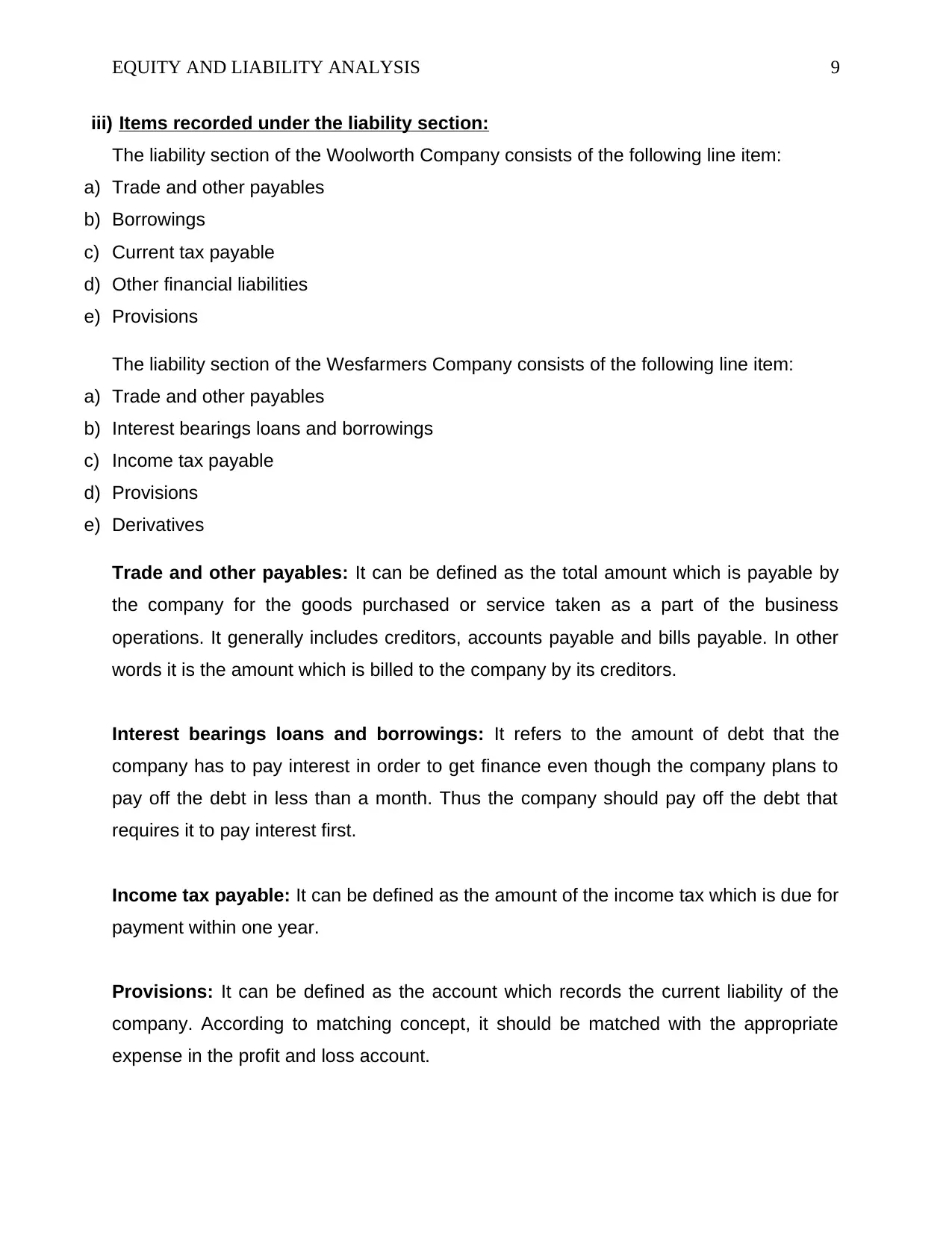
EQUITY AND LIABILITY ANALYSIS 9
iii) Items recorded under the liability section:
The liability section of the Woolworth Company consists of the following line item:
a) Trade and other payables
b) Borrowings
c) Current tax payable
d) Other financial liabilities
e) Provisions
The liability section of the Wesfarmers Company consists of the following line item:
a) Trade and other payables
b) Interest bearings loans and borrowings
c) Income tax payable
d) Provisions
e) Derivatives
Trade and other payables: It can be defined as the total amount which is payable by
the company for the goods purchased or service taken as a part of the business
operations. It generally includes creditors, accounts payable and bills payable. In other
words it is the amount which is billed to the company by its creditors.
Interest bearings loans and borrowings: It refers to the amount of debt that the
company has to pay interest in order to get finance even though the company plans to
pay off the debt in less than a month. Thus the company should pay off the debt that
requires it to pay interest first.
Income tax payable: It can be defined as the amount of the income tax which is due for
payment within one year.
Provisions: It can be defined as the account which records the current liability of the
company. According to matching concept, it should be matched with the appropriate
expense in the profit and loss account.
iii) Items recorded under the liability section:
The liability section of the Woolworth Company consists of the following line item:
a) Trade and other payables
b) Borrowings
c) Current tax payable
d) Other financial liabilities
e) Provisions
The liability section of the Wesfarmers Company consists of the following line item:
a) Trade and other payables
b) Interest bearings loans and borrowings
c) Income tax payable
d) Provisions
e) Derivatives
Trade and other payables: It can be defined as the total amount which is payable by
the company for the goods purchased or service taken as a part of the business
operations. It generally includes creditors, accounts payable and bills payable. In other
words it is the amount which is billed to the company by its creditors.
Interest bearings loans and borrowings: It refers to the amount of debt that the
company has to pay interest in order to get finance even though the company plans to
pay off the debt in less than a month. Thus the company should pay off the debt that
requires it to pay interest first.
Income tax payable: It can be defined as the amount of the income tax which is due for
payment within one year.
Provisions: It can be defined as the account which records the current liability of the
company. According to matching concept, it should be matched with the appropriate
expense in the profit and loss account.
⊘ This is a preview!⊘
Do you want full access?
Subscribe today to unlock all pages.

Trusted by 1+ million students worldwide

EQUITY AND LIABILITY ANALYSIS 10
Derivatives: They are used to hedge the position or have speculation on the movement
of an underlying asset and their values are derived from the fluctuations of the value of
the underlying assets.
iv) Movement in each item of the liability section:
The movement in the liability section of the Woolworth can be discussed as below:
a) Trade and other payables: The balance of this account has increased over the period of
three years which states that the company liability has increased in terms of payable. It
is increased due to increase in trade payables and unearned income.
b) Borrowings:
Derivatives: They are used to hedge the position or have speculation on the movement
of an underlying asset and their values are derived from the fluctuations of the value of
the underlying assets.
iv) Movement in each item of the liability section:
The movement in the liability section of the Woolworth can be discussed as below:
a) Trade and other payables: The balance of this account has increased over the period of
three years which states that the company liability has increased in terms of payable. It
is increased due to increase in trade payables and unearned income.
b) Borrowings:
Paraphrase This Document
Need a fresh take? Get an instant paraphrase of this document with our AI Paraphraser

EQUITY AND LIABILITY ANALYSIS 11
c) Current tax payable: The amount of current tax which is due for payment to the
government has increased over the period of three years.
d) Other financial liabilities:
e) Provisions:
The liability section of the Wesfarmers Company consists of the following line item:
a) Trade and other payables: The amount of this account has increased in the year 2017
as compared to year 2016 because the due amount for payment has increased and it
c) Current tax payable: The amount of current tax which is due for payment to the
government has increased over the period of three years.
d) Other financial liabilities:
e) Provisions:
The liability section of the Wesfarmers Company consists of the following line item:
a) Trade and other payables: The amount of this account has increased in the year 2017
as compared to year 2016 because the due amount for payment has increased and it
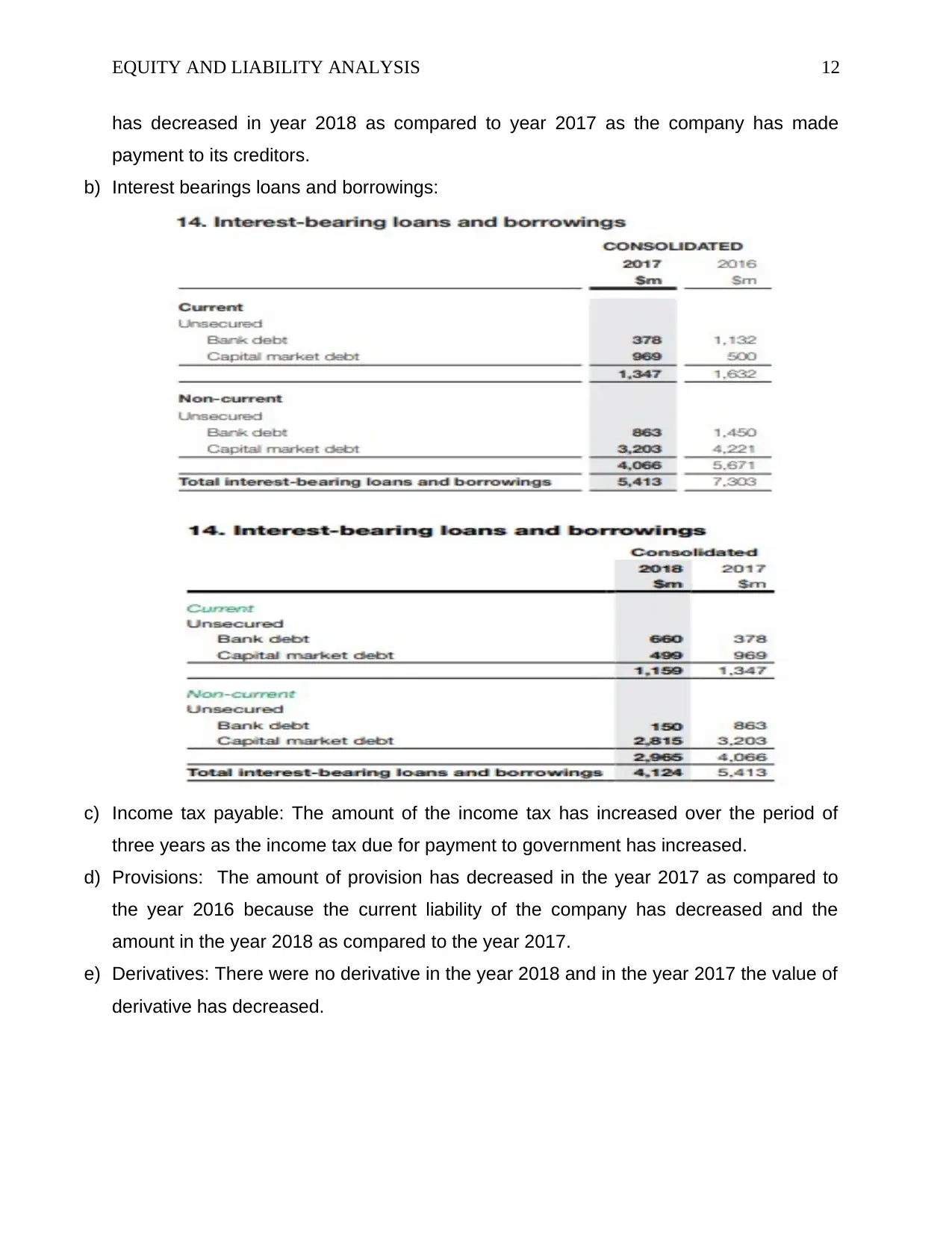
EQUITY AND LIABILITY ANALYSIS 12
has decreased in year 2018 as compared to year 2017 as the company has made
payment to its creditors.
b) Interest bearings loans and borrowings:
c) Income tax payable: The amount of the income tax has increased over the period of
three years as the income tax due for payment to government has increased.
d) Provisions: The amount of provision has decreased in the year 2017 as compared to
the year 2016 because the current liability of the company has decreased and the
amount in the year 2018 as compared to the year 2017.
e) Derivatives: There were no derivative in the year 2018 and in the year 2017 the value of
derivative has decreased.
has decreased in year 2018 as compared to year 2017 as the company has made
payment to its creditors.
b) Interest bearings loans and borrowings:
c) Income tax payable: The amount of the income tax has increased over the period of
three years as the income tax due for payment to government has increased.
d) Provisions: The amount of provision has decreased in the year 2017 as compared to
the year 2016 because the current liability of the company has decreased and the
amount in the year 2018 as compared to the year 2017.
e) Derivatives: There were no derivative in the year 2018 and in the year 2017 the value of
derivative has decreased.
⊘ This is a preview!⊘
Do you want full access?
Subscribe today to unlock all pages.

Trusted by 1+ million students worldwide
1 out of 17
Related Documents
Your All-in-One AI-Powered Toolkit for Academic Success.
+13062052269
info@desklib.com
Available 24*7 on WhatsApp / Email
![[object Object]](/_next/static/media/star-bottom.7253800d.svg)
Unlock your academic potential
Copyright © 2020–2025 A2Z Services. All Rights Reserved. Developed and managed by ZUCOL.





